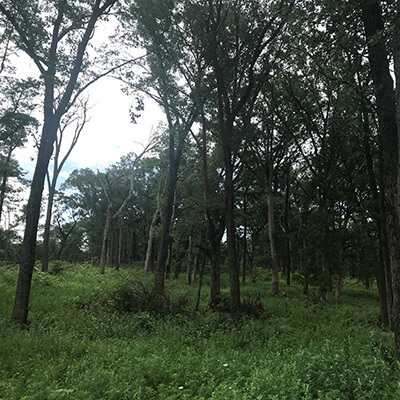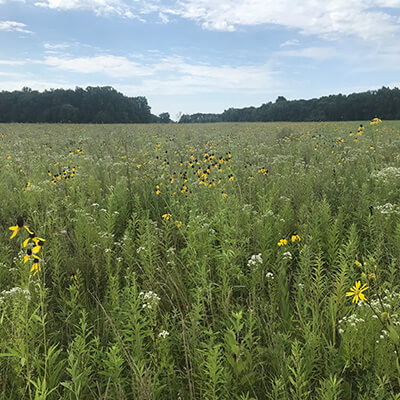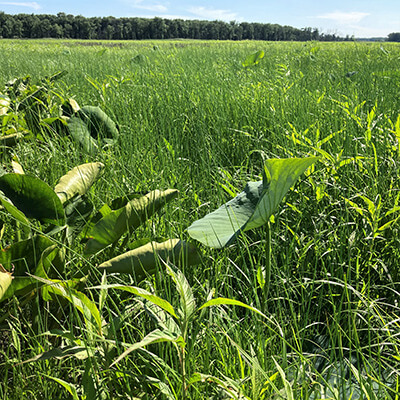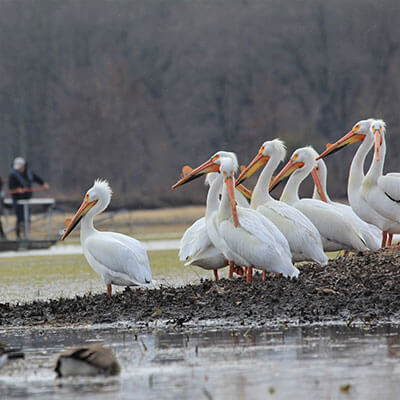Select image to enlarge and view caption.
Kankakee Region
What makes this region unique
The unique characteristics of the Kankakee region shape the fish and wildlife that inhabit it. When you visit the Kankakee Region, you’ll dive into large expanses of tallgrass that cover the area. You can see the mark of the tallgrass prairie on the plants and animals that live here, too, like the plains leopard frogs that thrive in unplowed areas and move to near marshy or wet areas to breed in the fall. As you walk along areas of wildflowers, you might hear an upland sandpiper give its characteristic “wolf whistle” call from a fencepost. You may also be lucky enough to see a plains pocket gopher zipping along before retreating into a large network of tunnels in the area’s sandy soil.
Along the Kankakee River, you can view remnants of the Great Kankakee Marsh, where ducks and sandhill cranes stop and rest during spring and fall migration each year. These grassy open areas transition to wooded savanna communities that are a rare type of habitat left in the state. Savannas are home to many unique species, including the ornate box turtle, which, unlike many other turtles in the state, prefers dry environments in which to live its long life.
The region is also unique in that it is home to fish and wildlife that thrive in its remaining wild places.
State wildlife action planning in the Kankakee region
In September 2023, partners from the Kankakee region convened with partners from the Great Lakes region to discuss the ecosystems that are in need of conservation in the Kankakee region. Then, conservation strategies were built around the most pressing threats to these ecosystems. In 2024, we’ll be working with partners to further refine elements of the regional plan. Partners who have not been involved in the work are welcome to participate in the refinement process.
Curious about who has been involved in the process? Check out our list of partners below.
- Thank you, partners!
- Acres Land Trust
- Audubon Great Lakes
- Ball State University
- Clear Lake Township Land Conservancy
- DNR Division of Fish & Wildlife
- DNR Division of Nature Preserves
- Ducks Unlimited
- Fort Wayne Zoo
- Friends of St. Joe River Association
- Global Center for Species Survival
- Goshen College
- Groundwork Indy
- Heartland Restoration Services
- Hoosier Environmental Council
- Indiana Association of Soil and Water Conservation Districts
- Indiana Audubon
- Indiana Conservation Cropping System
- Indiana Conservation Voters
- Indiana Land Protection Alliance
- Indiana State Department of Agriculture
- Indiana University Columbus
- Indiana Wildlife Federation
- National Park Service
- Natural Resources Conservation Service
- Northwestern Indiana Regional Planning Commission
- Purdue Fort Wayne
- Save the Dunes
- Shirley Heinze Land Trust
- State of Indiana Cooperative Invasive Species Management
- Steuben County SWCD
- The Nature Conservancy
- The Wetlands Initiative
- U.S Department of Agriculture-APHIS
- U.S. Fish and Wildlife Service-Private Lands
- University of Indianapolis
- Urban Waters
Interested in learning more about the progress of the Kankakee regional plan? Contact Elizabeth Mabee (SWAP@dnr.IN.gov; 463-203-3095).
Conservation at work
- Re-wilding grassland near Fisher Oak Savanna
In Jasper County, Fisher Oak Savanna, a property owned by NICHES Land Trust that holds both grasslands and savanna, sat next to acres of fallow fields. Wildlife biologist Mike Mycroft partnered with NICHES, which purchased 50 acres next to the property to restore it. By providing cost share through Division of Fish & Wildlife conservation programs to conduct prescribed fires and planting high-diversity mixes of seeds, Mycroft helped rehabilitate the land and highlight the county’s distinctive blend of grasslands and savanna.
The fields beside Fisher Oak Savanna could have been farmed or remained fallow and become a space for invasive species and shrubs to establish, but Mycroft wanted to create higher-quality habitat in the region. He also wanted to make a difference in Jasper County for its wildlife and people. Now that Mycroft has helped convert the farmland to grassland, the county has cleaner water and additional wildlife benefits alongside productive working lands. Mycroft sees Jasper County as an area with other opportunities to re-establish historic grasslands, wetlands, and savanna. “(The project) showcases how agriculture and conservation can work hand in hand rather easily,” Mycroft says.
Learn more about how we help landowners.

Fisher Oak Savanna.

A former agricultural field transforms into planted native species near Fisher Oak Savanna.

- J.C. Murphey Lake renovation: Great habitat for rare migratory birds
In 1951, J.C. Murphey Lake was created to provide an area for waterfowl to migrate. But since then, its habitat quality has declined. In 2022 and 2023, Mike Schoof, property manager at Willow Slough Fish & Wildlife Area, worked to enhance the marsh and lake habitat for secretive marsh birds that nest in the summers and others that migrate through Indiana during spring and fall. This renovation was a community effort that involved donations for fishing piers and docks as well as several volunteer opportunities.
Even while the lake restoration was in process, Schoof saw several rare shorebird species using the lake, and his goal is to maintain the diversity of creatures in Indiana, for both the benefit of the environment and the people. As the lake reopens to recreational activities, it will serve as an even better area for hunting, fishing, birding, and doing watercraft activities. “It’s also going to be better for people that use the space, too,” Schoof says. “A healthy marsh habitat yields better quality fish, more fish fry dinners with family, and making memories!”
Learn more about the exciting changes taking place at J.C. Murphey Lake.

A variety of plants respond to the change in water levels.

American white pelicans share space with DNR employees working on the J.C. Murphey Lake renovation.

Additional Resources
- Want to learn more about other fish and wildlife that live in Indiana?
- Read about this region in the Indiana State Wildlife Action Plan.
